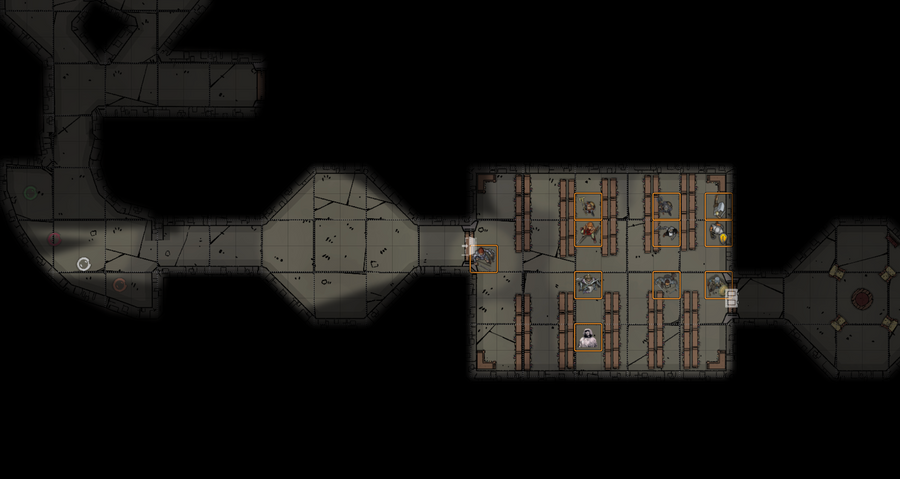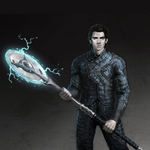Now that I've used it for a couple game sessions, the short version is that I am absolutely sold on how good Foundry is, as in worth every penny. If you don't want to spin up your own server, go buy a seat and pay the guys at Forge to host it. Even if you save nothing, you'll get a lot more value out of it.
The below is based on the ACKs rule/world set with a few modules added. I'll try note when something is an add-on or a core feature.
Gripes
I'm going to start with what is effectively my only real complaint about Foundry: the lack of prefab "mook" tokens.
Foundry's management area on the right is organized similar to Roll20 - a chat tab, a combat tab, a maps ("scenes") tab, an "actors" tab, journal entries, compendiums, and so forth.
Where in roll 20, at least in the paid tiers, there was a tab you could search through generic or paid image packs, or upload your own, and simply drag out a new token, nothing like that is in place. Yes, I'm aware that I can work around this, at least with the ACKs system rules loaded, using the Monster Compendium which has 40-odd creatures loaded, but a lot of the creatures in Dwimmermount simply don't exist there.
So, OK, the first time I set up the world I needed to create 20 or so "stub" creatures and upload tokens for them - which can only be uploaded one at a time using the GUI. I also needed a set of tokens uploaded for my existing players. (I ended up using the "scp" command to upload a zip file with everything I picked out and unpacking it....)
Much like a navy nuclear evaluation, if that's the worst ding against somthing, you're doing pretty well.
Everything Else
One comment I'd seen on Foundry was that someone obviously had looked at Roll20 and asked "how could I do each of these things better?"
The chat panel simply looks nicer. That's without the add-on modules I've dropped in like Dice so Nice! for 3d dice. The syntax for rolls is similar to Roll20, and you can easily drop a standard die roll into a macro - which also supports more complicated scripting.
The combat tracker, a default feature, makes rolling and tracking initiative a snap.
Maps - or "scenes" (OK, second gripe, I'm not a story gamer, these are not scenes in a play....) - is the first place that Foundry truly beats the stuffing out of Roll20, because instead of a slide-down sheet with a row of dozens of maps arbitrarily sorted as you drag them back and forth with no hierarchy, you can sort the maps into folders. The wilderness and Muntberg area maps have their own folder, the Dwimmermount maps another, and other locations the players have gone yet another or more. Also - scaling a map to fit is childishly easy on square grid - the minimum map size is 50px/grid unit. Upload the file, give it the dimensions and pixels/grid, and if needed, an offset, and you have a map properly positioned in seconds without the fiddling that R20 usually required. Hex grids are a bit more finicky, as the width of an individual hex from vertex to vertex is not the width of two columns of hexes, but if you go to this calc site you'll find that, for the vertical column maps like Dwimmermount uses for wilderness, a hex width of 52 pixels (which Foundry uses) results in an average center-to-center column width (the radial distance out to a vertex, plus 1/2 the width of the side) of 39 pixels. So if your map is supposed to be 20 columns wide with 52-pixel hexes, it should be 780 pixels wide. In general though, with hexmaps, I prefer them NOT being preprinted with gridlines.
The options for global or "token" illumination are easy to figure out with a little experimentation, and walls and light sources are very easy to place, even for a large megadungeon level, with options for doors that players can open, secret doors they cannot, and walls that pass light or block movement in different unusual ways - including "terrain" walls that let you circle a boulder such that the boulder itself is visible, but nothing beyond it.
The dynamic fog of war allows players to faintly see any part of the map any player token has seen (designated with "has vision"), but still allows what the players directly see to be limited by walls and light.
Incidentally, I set the player "prototype" token to allow "bright" vision for 4' and "dim" for 6' so that they can always find their token, and see what is most immediately around them, though no further without other light sources. I also similarly set the torchbearers as light sources.
Oh - and you can easily place light sources all over the map, including their reach, color, and basic animations such as flickering, pulsing, etc.
"Actors" is where player characters, henchmen, and NPCs/monsters go. I keep them sorted into different folders, and the folders can be color coded. Dragging a character onto the map is dead simple, and each "actor" has a defined prototype token that presets the size, vision, light, and so forth, if any, as well as if the dragged-out token is linked back to a player character or its own entity.
I've settled on setting the following for prototype tokens:
- the Token name
- Display the name if hovered by anyone ( showing all anmes all the time gets cluttered)
- The actor the token is associated with
- "Link Actor Data" so the tokens across maps stay in sync for players (I do NOT do this for most monsters)
- I choose an image from the image browser - which despite the upload limits is otherwise excellent - and leave the default size of 1:1 (unless we're talking a dragon, etc)
- Under vision I set "has vision" and dim/bright to 6 and 4. Unless the character typically carries a light source (such as Three Steps, the party cleric), I leave light alone.
- Aaaand "Update token."
For spellcasters I check off the box under "tweaks" to expose a spell list. The only quirk/bug I've found in the ACKs ruleset is the inability to "wear" and sum up more than one type of armor. our workaround is to list all the armor carried with weights and AC, and then create a weightless summary armor item with just the AC for a standard loadout, and equip THAT.
Incidentally, rolling up a fresh character for a new player and delegating a token/control is much simpler overall than Roll 20 - you can even roll the stats right on the sheet, and under the ACKs ruleset, it's smart enough to add bonuses, etc. to combat rolls and AC if you also enter weapon bonuses and damage, as well as class-based bonuses under tweaks. As a result, a combat roll can be executed by selecting the weapon on your character sheet and hitting the die icon.
Journals work how you expect - again, there are color-coded folders, and you can set visibility to players item by item. There's a list of artifacts and who's carrying them that I made editable - and that I also use the GM notes plugin/module to keep hidden notes on what some of those bottles really are.
Speaking of modules, I use the following:
- Combat enhancements
- Compendium FOlders (loaded with ACKs)
- Dice So Nice for 3d dice
- Forein's Token Rotation to provide a rotation handle instead of the default SHIFT-(WSAD) for facing
- GM Notes - so I can tag non-player-visible notes on tokens, journals, maps, etc
- Group Initiative
- Permission Viewer - to make it easier to see permissions assigned to a token, journal, etc
- Pings, to allow hold-clicks to put a ping on the map. Much prettier than the roll20 version
- Show drag distance
- TinyMCE Custom Foundry File Picker - slightly improved set of icon/file views
- Universal Battlemap importer - allows you to import maps from Duneondraft including walls and light sources.
One last feature - Roll tables. You can specify a table with a formula/die roll, and results for various roll ranges, which can be text, actual items or actors, etc.. I've already set up wandering monster tables for the current and adjacent levels in Dwimmermount, and the ACKs rules have included the complete treasure tables in the compendium.
Again. All in all, worth every penny.

